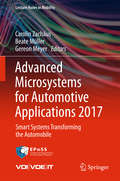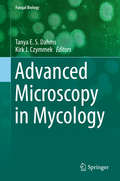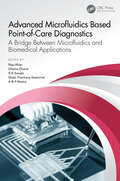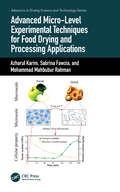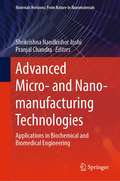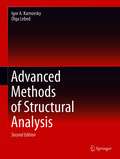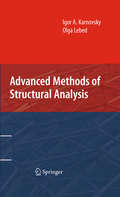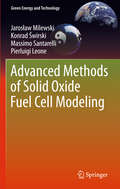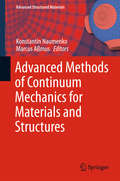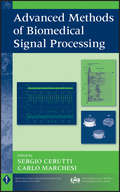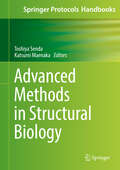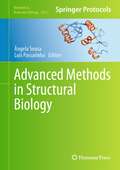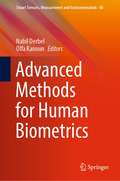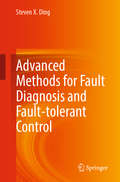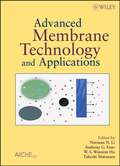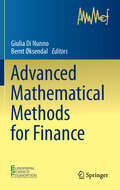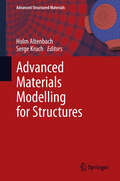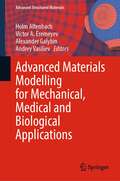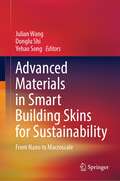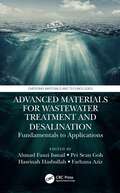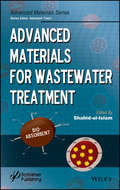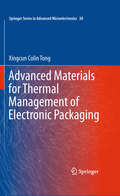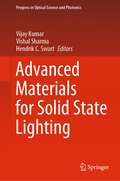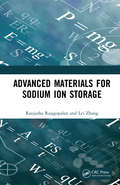- Table View
- List View
Advanced Microsystems for Automotive Applications 2017: Smart Systems Transforming the Automobile (Lecture Notes in Mobility)
by Gereon Meyer Beate Müller Carolin ZachäusThis volume of the Lecture Notes in Mobility series contains papers written by speakers and poster presenters at the 21st International Forum on Advanced Microsystems for Automotive Applications (AMAA 2017) "Smart Systems Transforming the Automobile" that was held in Berlin, Germany in September 2017. The authors report about recent breakthroughs in electric and electronic components and systems, driver assistance and vehicle automation as well as safety and testing. Furthermore, legal aspects and impacts of connected and automated driving are covered. The target audience primarily comprises research experts and practitioners in industry and academia, but the book may also be beneficial for graduate students alike.
Advanced Microscopy in Mycology (Fungal Biology)
by Tanya E. S. Dahms Kirk J. CzymmekThe aim of this volume is to describe the latest advances in microscopic methods, including integrated techniques, as applied to mycology. Each chapter will provide a brief overview of a particular microscopic method with associated advantages and limitations, the research questions that can be appropriately addressed using these microscopic methods, how it has been successfully applied to address mycological research questions, including supporting and complimentary techniques, and which future questions can be addressed.
Advanced Microfluidics Based Point-of-Care Diagnostics: A Bridge Between Microfluidics and Biomedical Applications
by Raju Khan, Chetna Dhand, S. K. Sanghi, Shabi Thankaraj Salammal, and A. B. P. MishraThis book provides a well-focused and comprehensive overview of novel technologies involved in advanced microfluidics based diagnosis via various types of prognostic and diagnostic biomarkers. This authors examine microfluidics based diagnosis in the biomedical field as an upcoming field with extensive applications. It provides a unique approach and comprehensive technology overview for diagnosis management towards early stages of various bioanalytes via cancer diagnostics diabetes, alzheimer disease, toxicity in food products, brain and retinal diseases, cardiovascular diseases, and bacterial infections etc. Thus, this book would encompass a combinatorial approach of medical science, engineering and biomedical technology. The authors provide a well-focused and comprehensive overview of novel technologies involved in advanced microfluidics based diagnosis via various types of prognostic and diagnostic biomarkers. Moreover, this book contains detailed description on the diagnosis of novel techniques. This book would serve as a guide for students, scientists, researchers, and microfluidics based point of care technologies via smart diagnostics and to plan future research in this valuable field.
Advanced Micro-Level Experimental Techniques for Food Drying and Processing Applications (Advances in Drying Science and Technology)
by Azharul Karim Sabrina Fawzia Mohammad Mahbubur RahmanAlthough strides have been made to quantitatively explore micro-level structural changes during food processing using advanced technologies, there is currently no comprehensive book that details these developments. Therefore, the research community and related industries are not fully aware of the available techniques. Advanced Micro-Level Experimental Techniques for Food Drying and Processing Applications fills this gap. The book has been written based on the authors’ comprehensive knowledge and application of microimaging methods in the thermal processing of food. Features Describes the latest micro-level experimental methods primarily using microimaging techniques Presents detailed procedures of applying these techniques in food processing Highlights the current challenges of developing efficient and novel food processing systems Describes the fundamentals of water transport processes and associated morphological changes during thermal processing of food materials This book is written for researchers, chemical, food, and industrial engineers and advanced students seeking to solve problems of industrial food processing.
Advanced Micro- and Nano-manufacturing Technologies: Applications in Biochemical and Biomedical Engineering (Materials Horizons: From Nature to Nanomaterials)
by Shrikrishna Nandkishor Joshi Pranjal ChandraThis volume focuses on the fundamentals and advancements in micro and nanomanufacturing technologies applied in the biomedical and biochemical domain. The contents of this volume provide comprehensive coverage of the physical principles of advanced manufacturing technologies and the know-how of their applications in the fabrication of biomedical devices and systems. The book begins by documenting the journey of miniaturization and micro-and nano-fabrication. It then delves into the fundamentals of various advanced technologies such as micro-wire moulding, 3D printing, lithography, imprinting, direct laser machining, and laser-induced plasma-assisted machining. It also covers laser-based technologies which are a promising option due to their flexibility, ease in control and application, high precision, and availability. These technologies can be employed to process several materials such as glass, polymers: polycarbonate, polydimethylsiloxane, polymethylmethacrylate, and metals such as stainless steel, which are commonly used in the fabrication of biomedical devices, such as microfluidic technology, optical and fiber-optic sensors, and electro-chemical bio-sensors. It also discusses advancements in various MEMS/NEMS based technologies and their applications in energy conversion and storage devices. The chapters are written by experts from the fields of micro- and nano-manufacturing, materials engineering, nano-biotechnology, and end-users such as clinicians, engineers, academicians of interdisciplinary background. This book will be a useful guide for academia and industry alike.
Advanced Methods of Structural Analysis
by Igor A. Karnovsky Olga LebedThis revised and significantly expanded edition contains a rigorous examination of key concepts, new chapters and discussions within existing chapters, and added reference materials in the appendix, while retaining its classroom-tested approach to helping readers navigate through the deep ideas, vast collection of the fundamental methods of structural analysis. The authors show how to undertake the numerous analytical methods used in structural analysis by focusing on the principal concepts, detailed procedures and results, as well as taking into account the advantages and disadvantages of each method and sphere of their effective application. The end result is a guide to mastering the many intricacies of the range of methods of structural analysis. The book differentiates itself by focusing on extended analysis of beams, plane and spatial trusses, frames, arches, cables and combined structures; extensive application of influence lines for analysis of structures; simple and effective procedures for computation of deflections; introduction to plastic analysis, stability, and free and forced vibration analysis, as well as some special topics. Ten years ago, Professor Igor A. Karnovsky and Olga Lebed crafted a must-read book. Now fully updated, expanded, and titled Advanced Methods of Structural Analysis (Strength, Stability, Vibration), the book is ideal for instructors, civil and structural engineers, as well as researches and graduate and post graduate students with an interest in perfecting structural analysis.
Advanced Methods of Structural Analysis
by Olga Lebed Igor A. KarnovskyAdvanced Methods of Structural Analysis aims to help its readers navigate through the vast field of structural analysis. The book aims to help its readers master the numerous methods used in structural analysis by focusing on the principal concepts, as well as the advantages and disadvantages of each method. The end result is a guide to mastering the many intricacies of the plethora of methods of structural analysis. The book differentiates itself from other volumes in the field by focusing on the following: * Extended analysis of beams, trusses, frames, arches and cables * Extensive application of influence lines for analysis of structures * Simple and effective procedures for computation of deflections * Introduction to plastic analysis, stability, and free vibration analysis Authors Igor A. Karnovsky and Olga Lebed have crafted a must-read book for civil and structural engineers, as well as researches and students with an interest in perfecting structural analysis. Advanced Methods of Structural Analysis also offers numerous example problems, accompanied by detailed solutions and discussion of the results.
Advanced Methods of Solid Oxide Fuel Cell Modeling (Green Energy and Technology)
by Jarosław Milewski Pierluigi Leone Massimo Santarelli Konrad ŚwirskiFuel cells are widely regarded as the future of the power and transportation industries. Intensive research in this area now requires new methods of fuel cell operation modeling and cell design. Typical mathematical models are based on the physical process description of fuel cells and require a detailed knowledge of the microscopic properties that govern both chemical and electrochemical reactions. Advanced Methods of Solid Oxide Fuel Cell Modeling proposes the alternative methodology of generalized artificial neural networks (ANN) solid oxide fuel cell (SOFC) modeling. Advanced Methods of Solid Oxide Fuel Cell Modeling provides a comprehensive description of modern fuel cell theory and a guide to the mathematical modeling of SOFCs, with particular emphasis on the use of ANNs. Up to now, most of the equations involved in SOFC models have required the addition of numerous factors that are difficult to determine. The artificial neural network (ANN) can be applied to simulate an object's behavior without an algorithmic solution, merely by utilizing available experimental data. The ANN methodology discussed in Advanced Methods of Solid Oxide Fuel Cell Modeling can be used by both researchers and professionals to optimize SOFC design. Readers will have access to detailed material on universal fuel cell modeling and design process optimization, and will also be able to discover comprehensive information on fuel cells and artificial intelligence theory.
Advanced Methods of Continuum Mechanics for Materials and Structures (Advanced Structured Materials #60)
by Konstantin Naumenko Marcus AßmusThis volume presents a collection of contributions on advanced approaches of continuum mechanics, which were written to celebrate the 60th birthday of Prof. Holm Altenbach. The contributions are on topics related to the theoretical foundations for the analysis of rods, shells and three-dimensional solids, formulation of constitutive models for advanced materials, as well as development of new approaches to the modeling of damage and fractures.
Advanced Methods of Biomedical Signal Processing (IEEE Press Series on Biomedical Engineering #27)
by Sergio Cerutti Carlo MarchesiThis book grew out of the IEEE-EMBS Summer Schools on Biomedical Signal Processing, which have been held annually since 2002 to provide the participants state-of-the-art knowledge on emerging areas in biomedical engineering. Prominent experts in the areas of biomedical signal processing, biomedical data treatment, medicine, signal processing, system biology, and applied physiology introduce novel techniques and algorithms as well as their clinical or physiological applications. The book provides an overview of a compelling group of advanced biomedical signal processing techniques, such as multisource and multiscale integration of information for physiology and clinical decision; the impact of advanced methods of signal processing in cardiology and neurology; the integration of signal processing methods with a modelling approach; complexity measurement from biomedical signals; higher order analysis in biomedical signals; advanced methods of signal and data processing in genomics and proteomics; and classification and parameter enhancement.
Advanced Methods in Structural Biology (Springer Protocols Handbooks)
by Toshiya Senda Katsumi MaenakaThis book provides practical information on a whole set of protein experiments for advanced structural biology, such as X-ray crystallography, NMR, electron microscopy, advanced mass spectroscopy, and surface plasmon resonance, as well as a wide variety of expression systems including eukaryotic and in vitro expression. In the past decade, structural genomics studies have pushed forward the development of automated methods in the field of structural biology, however there is an increasing need for the structural analysis of difficult targets, such as large protein complexes and membrane proteins, which are hard to achieve using conventional automated methods, and require knowledge that goes beyond standard protein chemistry protocols. To address these problems and to help researchers develop novel methods, this volume provides examples of the development of new protein investigation methods and their theoretical background. This book particularly appeals to graduate students, postdoctoral researchers, young investigators wishing to gain a better understanding of the theory behind experiments, and those seeking further advanced, practical structural biology methods.
Advanced Methods in Structural Biology (Methods in Molecular Biology #2652)
by Ângela Sousa Luis PassarinhaThis volume explores the latest integrated bioprocesses and technologies used to study the production of the target recombinant protein of therapeutic or diagnostic interest; its isolation, purification, and stabilization; and the bio-interaction and structural analyses. The chapters in this book are organized into four parts. Part One covers production methods of soluble and membrane proteins in prokaryotic and eukaryotic expression systems, such as Lactococcus lactis and Escherichia coli. Part Two describes traditional and novel approaches for recombinant protein purification and stabilization, and buffers and additives. Part Three discusses automated methods in structural biology based on in silico approaches; and Part Four provides examples of advanced protein investigation methodologies to assess structural analysis such as high-throughput protein crystallization and time-resolved serial crystallography. Written in the highly successful Methods in Molecular Biology series format, chapters include introductions to their respective topics, lists of the necessary materials and reagents, step-by-step, readily reproducible laboratory protocols, and tips on troubleshooting and avoiding known pitfalls.Cutting-edge and comprehensive, Advanced Methods in Structural Biology is a valuable resource to those in academia (i.e., graduate students and postdoctoral researchers) and researchers in the pharmaceutical industry who wish to learn more about this developing field. Chapter 5 is available open access under a Creative Commons Attribution 4.0 International License via link.springer.com.
Advanced Methods for Human Biometrics (Smart Sensors, Measurement and Instrumentation #40)
by Nabil Derbel Olfa KanounThe book highlights recent developments in human biometrics, covering a wide range of methods based on biological signals, image processing, and measurements of human characteristics such as fingerprints and iris or medical characteristics. Human Biometrics is becoming increasingly crucial in forensics security and medicine. They provide a solid basis for identifying individuals based on unique physical characteristics or diseases based on characteristic biomedical measurements. As such, the book offers an essential reference guide about biometry methods for students, engineers, designers, and technicians.
Advanced methods for fault diagnosis and fault-tolerant control
by Steven X. DingThe major objective of this book is to introduce advanced design and (online) optimization methods for fault diagnosis and fault-tolerant control from different aspects. Under the aspect of system types, fault diagnosis and fault-tolerant issues are dealt with for linear time-invariant and time-varying systems as well as for nonlinear and distributed (including networked) systems. From the methodological point of view, both model-based and data-driven schemes are investigated.To allow for a self-contained study and enable an easy implementation in real applications, the necessary knowledge as well as tools in mathematics and control theory are included in this book. The main results with the fault diagnosis and fault-tolerant schemes are presented in form of algorithms and demonstrated by means of benchmark case studies. The intended audience of this book are process and control engineers, engineering students and researchers with control engineering background.
Advanced Membrane Technology and Applications
by Norman N Li W. S. Ho Takeshi Matsuura Anthony G. FaneAdvanced membranes-from fundamentals and membrane chemistry to manufacturing and applicationsA hands-on reference for practicing professionals, Advanced Membrane Technology and Applications covers the fundamental principles and theories of separation and purification by membranes, the important membrane processes and systems, and major industrial applications. It goes far beyond the basics to address the formulation and industrial manufacture of membranes and applications.This practical guide: Includes coverage of all the major types of membranes: ultrafiltration; microfiltration; nanofiltration; reverse osmosis (including the recent high-flux and low-pressure membranes and anti-fouling membranes); membranes for gas separations; and membranes for fuel cell uses Addresses six major topics: membranes and applications in water and wastewater; membranes for biotechnology and chemical/biomedical applications; gas separations; membrane contractors and reactors; environmental and energy applications; and membrane materials and characterization Includes discussions of important strategic issues and the future of membrane technologyWith chapters contributed by leading experts in their specific areas and a practical focus, this is the definitive reference for professionals in industrial manufacturing and separations and research and development; practitioners in the manufacture and applications of membranes; scientists in water treatment, pharmaceutical, food, and fuel cell processing industries; process engineers; and others. It is also an excellent resource for researchers in industry and academia and graduate students taking courses in separations and membranes and related fields.
Advanced Mechanics and General Relativity
by Joel FranklinAimed at advanced undergraduates with background knowledge of classical mechanics and electricity and magnetism, this textbook presents both the particle dynamics relevant to general relativity, and the field dynamics necessary to understand the theory. Focusing on action extremization, the book develops the structure and predictions of general relativity by analogy with familiar physical systems. Topics ranging from classical field theory to minimal surfaces and relativistic strings are covered in a homogeneous manner. Nearly 150 exercises and numerous examples throughout the textbook enable students to test their understanding of the material covered. A tensor manipulation package to help students overcome the computational challenge associated with general relativity is available on a site hosted by the author. A link to this and to a solutions manual can be found at www. cambridge. org/9780521762458.
Advanced Mathematical Methods for Finance
by Giulia Di Nunno Bernt ØksendalThis book presents innovations in the mathematical foundations of financial analysis and numerical methods for finance and applications to the modeling of risk. The topics selected include measures of risk, credit contagion, insider trading, information in finance, stochastic control and its applications to portfolio choices and liquidation, models of liquidity, pricing, and hedging. The models presented are based on the use of Brownian motion, Lévy processes and jump diffusions. Moreover, fractional Brownian motion and ambit processes are also introduced at various levels. The chosen blend of topics gives an overview of the frontiers of mathematics for finance. New results, new methods and new models are all introduced in different forms according to the subject. Additionally, the existing literature on the topic is reviewed. The diversity of the topics makes the book suitable for graduate students, researchers and practitioners in the areas of financial modeling and quantitative finance. The chapters will also be of interest to experts in the financial market interested in new methods and products. This volume presents the results of the European ESF research networking program Advanced Mathematical Methods for Finance.
Advanced Materials Modelling for Structures: With Multi-scale Effects Or Under Multi-field Actions (Advanced Structured Materials #19)
by Holm Altenbach Serge KruchThis volume presents the major outcome of the IUTAM symposium on "Advanced Materials Modeling for Structures". It discusses advances in high temperature materials research, and also to provides a discussion the new horizon of this fundamental field of applied mechanics. The topics cover a large domain of research but place a particular emphasis on multiscale approaches at several length scales applied to non linear and heterogeneous materials. Discussions of new approaches are emphasised from various related disciplines, including metal physics, micromechanics, mathematical and computational mechanics.
Advanced Materials Modelling for Mechanical, Medical and Biological Applications (Advanced Structured Materials #155)
by Holm Altenbach Victor A. Eremeyev Alexander Galybin Andrey VasilievThe book is devoted to the 70th birthday of Prof. Sergey M. Aizikovich, which will celebrated on August 2nd 2021. His scientific interests are related to the following topics: Mechanics of contact interactions, Functionally graded materials, Mechanics of fracture, Integral equations of mathematical physics, Inverse problems of the theory of elasticity, and Applications of elasticity to biological and medical problems of mechanics of materials. The papers, collected in the book, are contributions of authors from 10 countries.
Advanced Materials in Smart Building Skins for Sustainability: From Nano to Macroscale
by Julian Wang Donglu Shi Yehao SongConventional building skins are constructed as static structures upon the typical design conditions in terms of external climate and internal occupant activities. This generates dissociation between the envelope structure and its environment. With the emerging advanced materials, such as chromic-based materials, spectrally selective coatings, and transparent photovoltaic, more dynamic and smarter building skins are now achievable and constructible. This book updates readers on the key areas of smart building skins embodied in the novel advanced materials with unique structures and smart properties that enable multiple functions in energy efficiency, solar harvesting, and environmental greenness. It synergistically integrates the topics and knowledge of material design and experimental studies, theoretical analyses of building energy-saving mechanisms and solar energy utilization, and new design methodologies and processes taking advanced materials into account at different scales - from nano to the macroscale.
Advanced Materials for Wastewater Treatment and Desalination: Fundamentals to Applications (Emerging Materials and Technologies)
by Pei Sean Goh Hasrinah Hasbullah Farhana Aziz Ahmad Fauzi IsmailAdvanced Materials for Wastewater Treatment and Desalination: Fundamentals to Applications offers a comprehensive overview of current progress in the development of advanced materials used in wastewater treatment and desalination. The book is divided into two major sections, covering both fundamentals and applications. This book: Describes the synthesis and modification of advanced materials, including metal oxides, carbonaceous materials, perovskite-based materials, polymer-based materials, and advanced nanocomposites Examines relevant synthesis routes and mechanisms as well as correlates materials' properties with their characterization Details new fabrication techniques including green synthesis, solvent-free, and energy-saving synthesis approaches Highlights various applications, such as removal of organic contaminants, discoloration of dye wastewater, petrochemical wastewater treatment, and electrochemically-enhanced water treatment With chapters written by leading researchers from around the world, this book will be of interest to chemical, materials, and environmental engineers working on progressing materials applications to improve water treatment technologies.
Advanced Materials for Wastewater Treatment
by Shahid Ul-IslamOver the past few decades, rapid industrialization, fast urban encroachment, and improved agricultural operations have introduced substantial amounts of potentially toxic organic substances into the atmosphere and into the aquatic and terrestrial environments. Advanced Materials for Wastewater Treatment brings together innovative methodologies and research strategies to remove toxic effluents from wastewaters.With contributions from leading scientists from all around the world, the book provides a comprehensive coverage of the current literature, up-to-date overviews of all aspects of toxic chemical remediation including the role of nanomaterials.
Advanced Materials for Thermal Management of Electronic Packaging (Springer Series in Advanced Microelectronics #30)
by Xingcun Colin TongThe need for advanced thermal management materials in electronic packaging has been widely recognized as thermal challenges become barriers to the electronic industry's ability to provide continued improvements in device and system performance. With increased performance requirements for smaller, more capable, and more efficient electronic power devices, systems ranging from active electronically scanned radar arrays to web servers all require components that can dissipate heat efficiently. This requires that the materials have high capability of dissipating heat and maintaining compatibility with the die and electronic packaging. In response to critical needs, there have been revolutionary advances in thermal management materials and technologies for active and passive cooling that promise integrable and cost-effective thermal management solutions. This book meets the need for a comprehensive approach to advanced thermal management in electronic packaging, with coverage of the fundamentals of heat transfer, component design guidelines, materials selection and assessment, air, liquid, and thermoelectric cooling, characterization techniques and methodology, processing and manufacturing technology, balance between cost and performance, and application niches. The final chapter presents a roadmap and future perspective on developments in advanced thermal management materials for electronic packaging.
Advanced Materials for Solid State Lighting (Progress in Optical Science and Photonics #25)
by Vijay Kumar Vishal Sharma Hendrik C. SwartThis book highlights the synthesis, luminescence, and applications of rare earth-doped phosphors materials for solid-state lighting. Solid-state lighting is turning into a leading technology in the lighting industry, permitting improvement in the fields from architectural to domestic applications. Driven with the aid of using ongoing multi-field research, solid-state lighting needs an improvement of various technologies: efficient and reliable light-emitting devices, devices for new functionalities, and optical solutions for beam shaping. Noteworthy research endeavors were aimed to find out eco-friendly, better performance, cost, and energy-efficient phosphor materials for the application in solid-state lighting devices. Power phosphor materials with advanced optical and photoluminescence properties in a wide range of areas have shared the research efforts in this sector aimed in the direction of achieving better material features. Rare earth ion-doped phosphor materials have been the subject of scientific interest because of their significant applications in a variety of fields such as display devices, temperature sensors, solar cells, bio-imaging, and optoelectronics devices. This book covers the broad aspects of organic and inorganic materials based on phosphor materials and is beneficial to researchers involved in these areas. This book is specially designed to provide an introductory concept of luminescent materials, particularly man-made (artificial) phosphors in a language comprehensible to beginners and students. The book also includes some new materials with promising technologies and upgraded properties that expose new potential possibilities are also highlighted.
Advanced Materials for Sodium Ion Storage
by Lei Zhang Ranjusha RajagopalanGlobally, lithium ion batteries (LIBs) are leaders in the energy storage sector but there are concerns regarding load leveling of renewable energy sources as well as smart grids and limited availability of lithium resources resulting in cost increase. Therefore, sodium ion batteries (SIBs) are being researched as next-generation alternatives to LIBs due to their similar sustainability and electrochemistry. This book mainly focuses on the current research on electrode materials and proposes future directions for SIBs to meet the current challenges associated with the full cell aspect. Further, it provide insights into scientific and practical issues in the development of SIBs.
